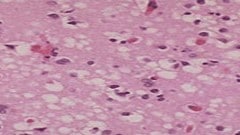What to know
- Classic CJD is a quick-moving, always fatal disease that occurs worldwide.
- It affects the brain and causes dementia and other problems.
- CJD mostly occurs in older adults.
- There is no treatment or cure.
- It usually leads to death within a year from when symptoms begin.

Overview
CJD is caused by a prion, a type of infectious protein. Prions trigger normal proteins in the body to misfold, leading to CJD.
CJD causes dementia and other neurologic problems. Once symptoms begin, it can lead to death in months to a year.
Classic CJD occurs worldwide in older adults, with the average age in the late 60s. Very few cases occur in people who are younger than 30 years old.
CJD occurs worldwide with an estimated rate of about one to two illness per one million population members per year. In recent years in the United States, about 500-600 cases have been reported per year.
Types
There are three main types of CJD infection:
Sporadic
The vast majority of all CJD cases reported (about 85 percent) are called sporadic. These types of cases occur when prion proteins already in the body misfold for some unknown reason. The result is disease that breaks down the brain's functions. Some cases are fatal within a few months of the first symptoms, and most are fatal within a year.
Familial
About 5-15 percent of CJD cases occur because the person has inherited a mutation in the prion protein gene. A person with CJD with a first-degree relative (parent, sibling, or child) who also has the disease would have familial CJD.
Iatrogenic
Iatrogenic cases are caused by contact with prions in a healthcare setting or due to biological products. There have been six known CJD cases caused by surgical or medical equipment contaminated with prions is used on another patient.
People who received prion-contaminated human growth hormone prior to 1978 may also develop iatrogenic CJD. Even 50 years later, cases are still being identified.
Finally, cases can occur in people who receive a transplant of specific materials. These include corneal (eye) grafts or dura mater (a membrane in the brain and spinal cord) grafts. If the donor had CJD that was not discovered before the donation, recipients can contract CJD.
How it affects your body
People with CJD suffer from dementia. Other symptoms may include trouble walking, sudden jerky movements, and visual disturbances. CJD patients usually die within one year following the onset of symptoms.
Testing and diagnosis
Healthcare providers can diagnose an illness as a suspect case based on:
- Symptoms and course of illness
- Tests of a person's spinal fluid
- Magnetic Resonance Imaging (MRI), a brain scan
- EEG, a test of electrical activity in the brain.
The only way to confirm CJD is through testing brain tissue from a biopsy or an autopsy.
Treatment and Prognosis
Classic CJD is always fatal, usually within a few months. There is unfortunately no therapy that will slow or stop the progression of disease. So, treatment involves supportive care to make the patient more comfortable.
Similar diseases
Though they have very similar names, CJD and variant CJD (vCJD) are not the same disease. Both are prion diseases. However, variant CJD is tied to eating meat from cows infected with bovine spongiform encephalopathy (sometimes called Mad Cow Disease). CJD, sometimes called "classic CJD" to avoid confusion, mostly occurs sporadically. Unlike variant CJD, classic CJD is not caused by any other prion disease.
In general, classic CJD affects people older than 55 while vCJD cases were younger, with an average age of 28. Classic CJD progresses much more quickly, causing death in an average of 4-5 months, while vCJD averages more than a year.
- National Institute of Neurological Disorders and Stroke - CJD Facts
- Creutzfeldt-Jakob Disease Foundation
- For Questions or Comments on Prions E-mail Us.
